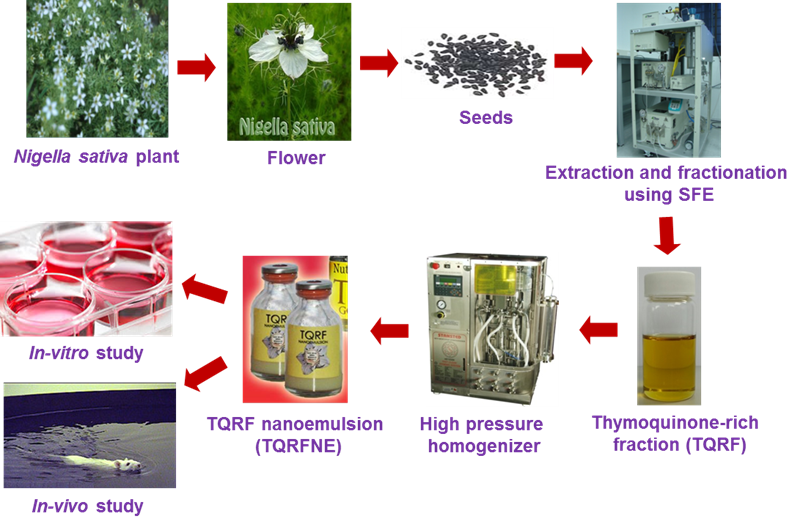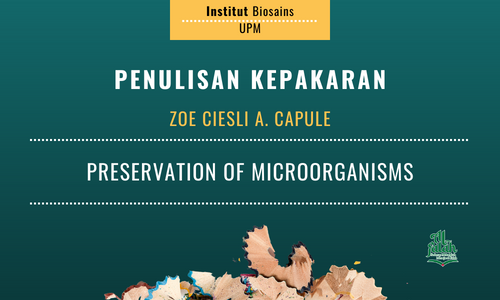Natural Medicine and Product Research Laboratory (NaturMeds),
Institute of Bioscience, Universiti Putra Malaysia, 43400 UPM Serdang, Selangor, Malaysia
Email: norsharina@upm.edu.my

Figure 1. Thymoquinone-rich fraction (TQRF) was extracted and fractionated from Nigella sativa seeds using a green technology supercritical fluid extraction (SFE) system exhibited a neuroprotective effect against oxidative stress-induced neuronal SH-SY5Y cells death via regulation of antioxidants and anti-apoptotic signalling pathways. The oral delivery of water-insoluble TQRF is improved through a nanotechnology approach by preparation of TQRF into TQRF nanoemulsion (TQRFNE). In a sporadic rat’s model of AD, TQRFNE improved cognitive function, ameliorated lipid peroxidation, enhanced antioxidants, and reduced inflammatory biomarkers and histological changes in the brain.
With an increase in lifespan due to better healthcare and changing population demographics, the incidence of neurodegenerative diseases including dementia is expected to increase significantly in the 21st century 1. It is a disease that develops when nerve cells (neurons) in the brain die or no longer function normally. The death or malfunction of these neurons causes memory loss, behavioral changes, and an inability to think clearly. An estimated 47 million people worldwide are living with dementia in 2015 2, and this number is projected to triple by 2050 3. In the absence of a disease-modifying treatment or cure, reducing the risk of developing dementia takes on added importance. Even when effective treatments become available, risk reduction will likely remain a fundamental strategy in reducing the number of individuals affected. As for many non-communicable diseases with available treatments (such as diabetes, cancer, and heart disease), risk reduction efforts remain a major component of the campaigns against these diseases 4.
Alzheimer’s disease (AD) is the most common type of dementia, which accounts for 60% to 80% of the cases 5. Studies indicate that people 65 and older survive an average of four to eight years after a diagnosis of AD, yet some live as long as 20 years with Alzheimer’s 6. This indicates the slow, insidious nature of the progression of Alzheimer’s. On average, a person with Alzheimer’s will spend more in the most severe stage of the disease than in any other stage 7. To date, no treatment is available to slow or stop AD progression. The existing five drugs approved by the U.S. Food and Drug Administration had only temporarily improved symptoms, in which their effectiveness varies across the population. None of the treatments available today alters the underlying course of this terminal disease 8.
Recent studies have shown that high cholesterol (i.e. hypercholesterolemia) levels are linked to the pathology of sporadic AD and the accumulation of protein β-amyloid, oxidative stress, declined spatial memory, inflammation, and induced blood brain barrier (BBB) leakage 9. In the current study, the thymoquinone-rich fraction (TQRF) extracted from Nigella sativa seed is selected as the main ingredient in the proposed nutraceutical product/drug alternative targeting the management of AD. However, the delivery of bioactive to the brain remains highly challenging for the treatment of AD. The development of new practical treatment modalities for the treatment of AD is currently a highly active area of research. The lipid-based nanoemulsion approach has attracted wide attention to improving the oral bioavailability of poorly water-soluble bioactive and delivery to the target site.
TQRF extracted and fractionated from N. sativa seeds using a green technology supercritical fluid extraction (SFE) system exhibited a neuroprotective effect against oxidative stress-induced neuronal SH-SY5Y cells death via regulation of antioxidants and anti-apoptotic signalling pathways. The oral delivery of water-insoluble TQRF is improved through a nanotechnology approach by preparation of TQRF into TQRF nanoemulsion (TQRFNE). In a sporadic rat’s model of AD, TQRFNE improved cognitive function, ameliorated lipid peroxidation, enhanced antioxidants, and reduced inflammatory biomarkers and histological changes in the brain (Figure 1). In addition, TQRFNE exerts multiple mechanisms of action in reducing β-amyloid accumulation in the brain, partly through modulation of its production, degradation, transportation, and clearance. In conclusion, N. sativa in particular TQRF could be developed into a novel nutraceutical product, especially to fight neurodegenerative diseases due to oxidative injury, and may be able to protect against this earlier destructive damage towards AD pathology.
Despite the potential benefits that can be derived from TQRF, future studies are needed to better understand the synergistic effects of the other constituents of the fraction besides TQ. Further details on the physicochemical properties and BBB penetration ability studies were essential. Future analyses involving the optimisation of absorption, distribution, metabolism, and excretion (ADME) profiles, as well as the pharmacokinetic/pharmacodynamic relationships, are also recommended to optimise the use of TQRFNE as a complementary or alternative therapeutic option. Finally, safety and tolerability studies as well as human clinical trials are needed to substantiate the therapeutic usefulness of TQRFNE in AD management.
References:-
- Alzheimer’s Association, 2017 Alzheimer’s disease facts and figures, Alzheimer’s & Dementia, 2017, 13, 325–373.
- M. Prince, M. Guerchet and M. Prina (2015), The Epidemiology and Impact of Dementia: Current State and Future Trends, Geneva: World Health Organization.
- M. Prince, M. Guerchet and M. Prina (2013), Alzheimer’s Disease International, Policy Brief for Heads of Government: The Global Impact of Dementia 2013-2050, London: Alzheimer’s Disease International.
- M. Baumgart, H. M. Snyder, M. C. Carrillo, S. Fazio, H. Kim and H. Johns, Summary of the evidence on modifiable risk factors for cognitive decline and dementia: A population-based perspective, Alzheimer’s & Dementia, 2015, 11, 718-726.
- A. Burns and S. Iliffe (2009), Alzheimer's disease, BMJ (Clinical research ed.) 338: b158, PMID 19196745.
- M. Ganguli, H. H. Dodge, C. Shen, R. S. Pandav and S. T. DeKosky, Alzheimer disease and mortality: A 15-year epidemiological study, Archives of Neurology, 2005, 62, 779–84.
- H. M. Arrighi, P. J. Neumann, I. M. Lieberburg and R. J. Townsend, Lethality of Alzheimer disease and its impact on nursing home placement, Alzheimer Disease & Associated Disorders, 2010, 24, 90–95.
- Alzheimer’s Association, 2012 Alzheimer’s disease facts and figures, Alzheimer’s & Dementia, 2012, 8, 131-168.
- L. R. Freeman, V. Haley-Zitlin, D. S. Rosenberger and A. C. Granholm, Damaging effects of a high-fat diet to the brain and cognition: A review of proposed mechanisms, Nutritional Neuroscience, 2014, 17, 241-251.
Tarikh Input: 08/08/2023 | Kemaskini: 08/08/2023 | azah
PERKONGSIAN MEDIA













.png)






